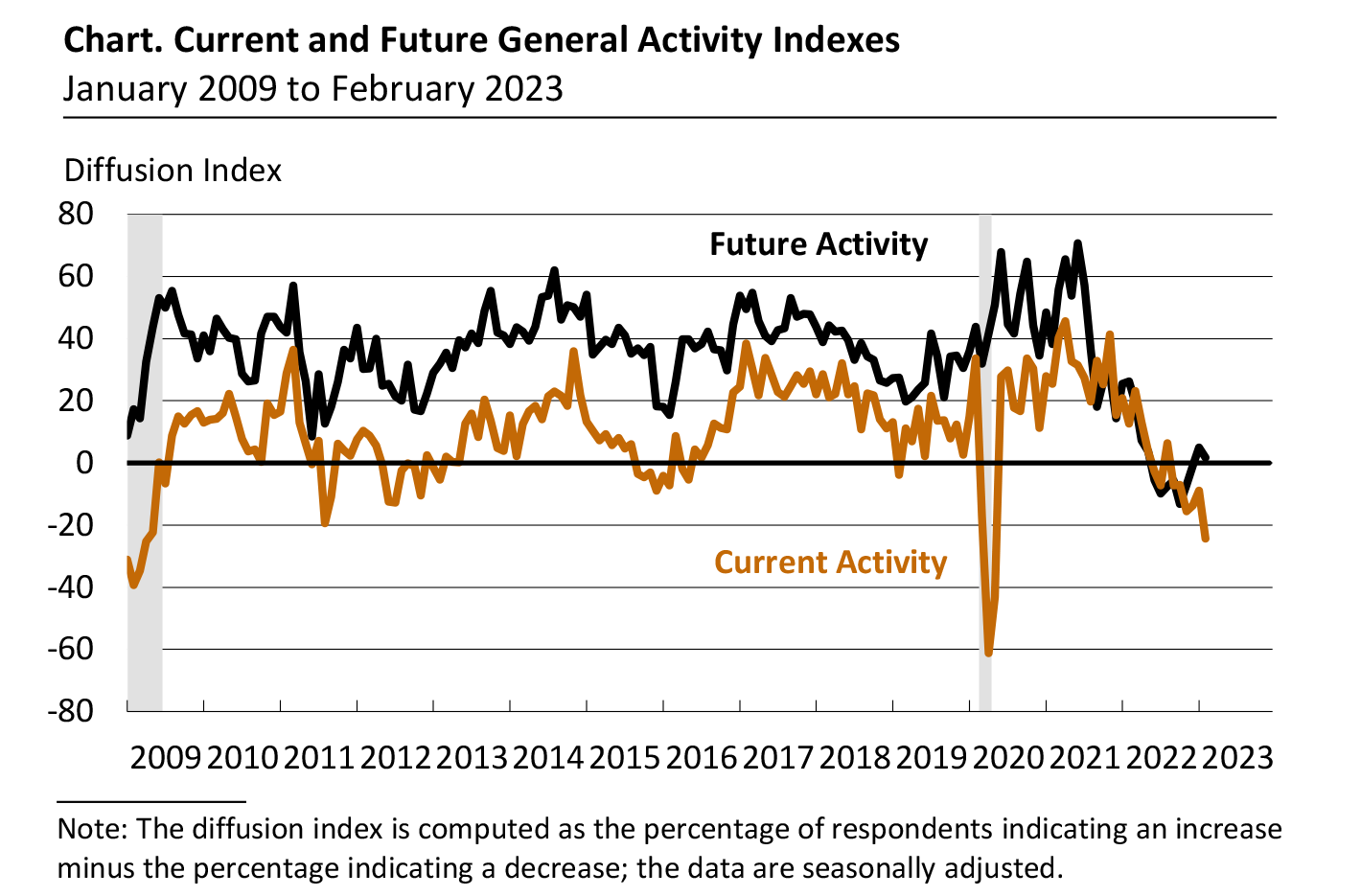February 2023 Manufacturing Business Outlook Survey
Note: Survey responses were collected from February 6 to February 13.
Manufacturing activity in the region continued to decline, according to the firms responding to the February Manufacturing Business Outlook Survey. The general activity index declined further, the new orders index remained negative, and the shipments index remained positive but low. The employment index declined but remained positive, and the price indexes continued to suggest overall increases but were in line with long-run averages. Most of the survey’s future indicators were positive but low, suggesting tempered expectations for growth over the next six months.
Current Indicators Remain Weak
The diffusion index for current activity fell from a reading of -8.9 last month to -24.3 this month (see Chart), its sixth consecutive negative reading and lowest reading since May 2020. Thirty-one percent of the firms reported decreases (down from 33 percent last month), exceeding the 7 percent reporting increases (down from 24 percent); 57 percent of the firms reported no change in current activity (up from 37 percent last month). The index for current new orders declined 3 points to -13.6, its ninth consecutive negative reading, and the current shipments index edged down 2 points to 8.7.
The current employment index remained positive but decreased from 10.9 to 5.1 this month. Most firms (61 percent) reported steady employment levels, 21 percent of the firms reported higher employment, and 15 percent reported lower employment. The average workweek index fell from 4.0 to -3.2.

Price Indexes Near Long-Run Averages
The prices paid diffusion index ticked up 2 points to 26.5, after reaching a two-and-a-half-year low last month. More than 34 percent of the firms reported increases in input prices, and 8 percent reported decreases; 55 percent reported no change. The current prices received index dropped 15 points to 14.9, its lowest reading since February 2021 and slightly above its long-run average. Almost 24 percent of the firms reported increases in the prices of their own goods, 9 percent reported decreases, and 65 percent reported no change.
Firms Expect Lower Increases in Prices from Last Quarter
In this month’s special questions, the firms were asked to forecast the changes in prices of their own products and for U.S. consumers over the next four quarters. Regarding their own prices over the next year, the firms’ median forecast was for an expected increase of 4.5 percent, down slightly from 4.8 percent when this question was last asked in November. The firms reported a median increase of 7.0 percent in their own prices over the past year, down from 7.5 percent in November. The firms’ median forecast for the rate of inflation for U.S. consumers over the next year was 4.0 percent, down from 5.0 percent in November. Over the long run, the firms’ median forecast for the 10-year average inflation rate was 3.0 percent, down from 4.0 percent in November.
Future Indicators Remain Soft
The diffusion index for future general activity declined 3 points but remained positive at 1.7 (see Chart). Almost 29 percent of the firms expect an increase in activity over the next six months, narrowly exceeding the 27 percent that expect a decrease. The future new orders index rose from 2.4 to 9.2, while the future shipments index declined from 9.1 to 4.6. The firms expect increases in employment overall, as the future employment index rose 10 points to 8.1, after dipping into negative territory last month. Both future price indexes were below their long-run averages. The future capital expenditures index edged down 3 points to 7.5.
Summary
Responses to the February Manufacturing Business Outlook Survey suggest continued overall declines in the region’s manufacturing sector this month. The indicators for current activity and new orders remained in negative territory, while the shipments index remained positive but low. The firms continued to indicate overall increases in prices paid and received. The survey’s future indexes continued to suggest tempered expectations for growth over the next six months.
Special Questions (February 2023)
| Please list the annual percent change with respect to the following: | ||
|---|---|---|
|
|
Current |
Previous (Nov. 2022) |
| For your firm: | ||
| Forecast for next year (2023Q1–2024Q1) | ||
| 1. Prices your firm will receive (for its own goods and services sold). | 4.5 | 4.8 |
| 2. Compensation your firm will pay per employee (for wages and benefits). | 4.8 | 5.0 |
| Last year's price change (2022Q1–2023Q1) | ||
| 3. Prices your firm did receive (for its own goods and services sold) over the last year. | 7.0 | 7.5 |
| For U.S. consumers: | ||
| 4. Prices U.S. consumers will pay for goods and services over the next year. | 4.0 | 5.0 |
| 5. Prices U.S. consumers will pay for goods and services over the next 10 years (2023–2032). | 3.0 | 4.0 |
| The numbers represent medians of the individual forecasts (percent changes). For question 5, firms reported a 10-year annual-average change. | ||
Return to the main page for the Manufacturing Business Outlook Survey.